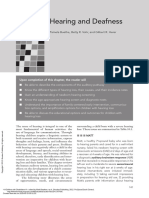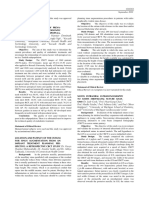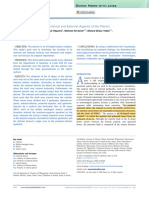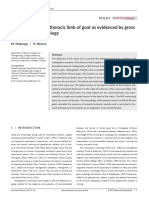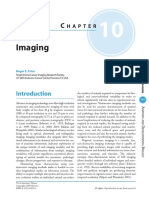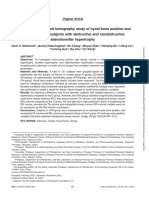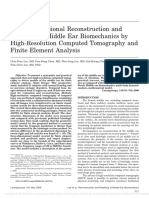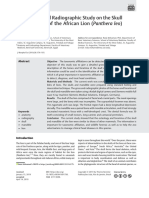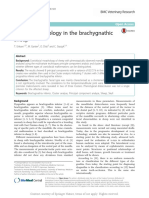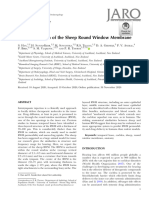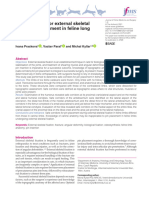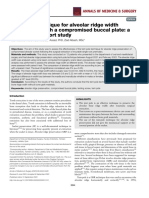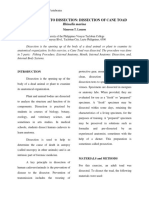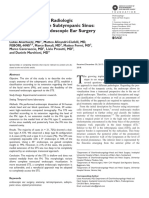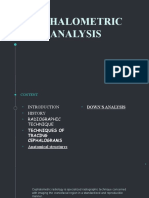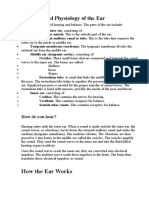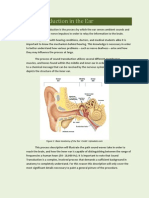Bjorl: Lambs' Temporal Bone Anatomy Under Didactic Aspects
Bjorl: Lambs' Temporal Bone Anatomy Under Didactic Aspects
Uploaded by
Fairus ZainCopyright:
Available Formats
Bjorl: Lambs' Temporal Bone Anatomy Under Didactic Aspects
Bjorl: Lambs' Temporal Bone Anatomy Under Didactic Aspects
Uploaded by
Fairus ZainOriginal Description:
Original Title
Copyright
Available Formats
Share this document
Did you find this document useful?
Is this content inappropriate?
Copyright:
Available Formats
Bjorl: Lambs' Temporal Bone Anatomy Under Didactic Aspects
Bjorl: Lambs' Temporal Bone Anatomy Under Didactic Aspects
Uploaded by
Fairus ZainCopyright:
Available Formats
Braz J Otorhinolaryngol.
2011;77(1):51-7.
ORIGINAL ARTICLE BJORL .org
Lambs’ temporal bone anatomy under didactic aspects
André Gurr1 , Marc David Pearson2 , Dazert S3
Keywords: Abstract
anatomy,
middle,
ear,
H uman temporal bones in teaching ear surgery are rare. The lamb’s temporal bone might be a
possible alternative.
temporal bone,
sheep,
Material and Methods: Temporal bones of the lamb were dissected with a typical temporal bone
veterinary.
lab drilling program. We included a mastoidectomy, endaural approaches, but also analyzed the outer
appearance, the external ear canal and the hypotympanon. Some steps differed from preparation
done in humans. The morphometric results were compared to the known anatomy of human in
order to verify the lambs` temporal bone for suitability in otosurgic training.
Results: The lambs’ temporal bone appears smaller than the human one. We found a bullous
extended hypotympanon located under the external ear canal. The tympanic membrane is very
similar to the human one. The external ear canal is smaller and shorter. The ossicular chain shows
analogies to human one.
Discussion: This study shows, that especially the middle ear, the tympanic membrane and the
external ear canal are morphologically equal to the structures found in human temporal bones. The
lamb seems feasible for teaching the anatomy of the ear. The smaller scales of some structures,
especially the outer components of the temporal bone are a disadvantage.
Conclusions: The lamb seems to be an alternative in teaching ear surgery.
1
Dr. med. (ENT-Specialist)
2
(Resident)
3
Prof. Dr. med. (Director of the Dept. of Otorhinolaryngology, Head- & Necksurgery, Ruhr-University Bochum, Germany)
Dept. of Otorhinolaryngology, Head & Necksurgery, Ruhr-University Bochum, Germany
Send correspondence to: Dr. med. A. Gurr Dept. of Otorhinolaryngology, Hea- & Necksurgery, Ruhr-University Bochum, Germany c/o St. Elisabeth Hospital Bleichstraße 15 44787
Bochum, Germany 0049 234 612 0 andre.gurr@rub.de
Paper submitted to the BJORL-SGP (Publishing Management System – Brazilian Journal of Otorhinolaryngology) on January 23, 2010;
and accepted on April 3, 2010. cod. 6892
Brazilian Journal of Otorhinolaryngology 77 (1) January/February 2011
http://www.bjorl.org / e-mail: revista@aborlccf.org.br
51
INTRODUCTION standard surgical light fountain used in endoscopic sur-
gery. We laid a small strip of foil containing units of 1 mm
The use of human temporal bones is limited by into the field of view. This strip was used as a reference
their bad availability. The usual alternatives for teaching for measurement calibration. The calibrating strip was
ear surgery are rare and consist of virtual temporal bo- positioned as near as possible to the measured structure.
nes or models. Unfortunately they are not suitable for The gauges were done with the help of the D-Cell
training chain reconstruction or preparatory work on Image analysis system which is a two-dimensional, pixel
the middle ear. Temporal bones retrieved from animals orientated software. After calibration of each single shot
might help to reduce the need for human biologics1-6 in the anatomical parameters were acquired. It was impor-
teaching and research. In order to verify the feasibility of ted to use views nearly perpendicular to the measured
the lambs temporal bone for ENT-education we designed structure in order to avoid faulty results.
this morphometric study. We determined the length and the smallest diame-
ter as well as the diameter at the orifice of the external
MATERIAL AND METHODS ear canal. The angles in two directions of the external
meatus were measured. The tympanic membrane was
gauged in length and height, as well as its nook to the
Prearrangement
external ear canal. In the middle ear spaces we quantified
We retrieved 12 heads of lambs, aged between
the length and sizes of all ossicules first in the middle ear
8 to 11 months from a local slaughterhouse. No animal
and again isolated after chain removal in order to proof
was killed for research purposes. The skin was removed,
the measuring method.
a sagittal separation of the heads was done and ventral
On the promontory, the sizes of the oval and the
parts of the heads were removed as well as the the brain.
round window and the distance of this structures were
These probes were fixated in formaline solution of 3 %
measured as well. The position of the cochlea was de-
for 6 to 8 weeks. The appending soft tissue was removed
termined and described, but not quantified.
from the fixated temporal bone in order to expose the
The structures found in mastoidectomy were des-
mastoidal plane and the external ear canal.
cribed and partially measured. The acquired data was
especially the angle of the short incus process to the
Preparation
lateral semicircular canal.
Before any manipulation on the temporal bones we
examined and described the outer anatomy. As a first dis-
RESULTS
section step the bullous hypotymanon was opened. This
allowed a good view from inferior into the middle ear.
Based on this approach we opened the external Outer appearance
ear canal, leaving the fibrous anulus of the tympanic Macroscopically the lamb’s temporal bone appears
membrane untouched in order to get a view on the smaller compared to human with a lot of similarities. The
tympanic membrane and the external ear canal suitable external ear canal is positioned humanlike and the mastoi-
for morphometric analysis. dal plane seems to have the same structural morphology.
The mastoidectomy was performed analogous to The distance between temporal line and cranium
the one in humans, between the temporal line and the was 1,71 cm on average. The atlanto-occipital joint is
posterior wall of the external ear canal including the vectored backwards as well as the foramen magnum. A
whole mastoidal plane. This procedure was done until styloid process cannot be found. The mastoid strongly
the semicircular canals, the access to the middle ear,the expands inferiorly.
facial nerve and the incus were visible. We found a bullous structure consisting of a thin
As last step the ossicular chain was removed. This bony layer, later identified as the hypotympanon, whi-
made morphometric studies on the promontory possible. ch measured 11,4 mm in depth and 23,2 mm in length
averaged (Figure 1).
Measurement External ear canal and tympanic membrane
The identified structures in all anatomical pre- The bony external ear canal is orientated on the
paration were measured by an optical measurement same axis as in humans but it has smaller scales. Its length
procedure. The optical views were grabbed by a digital was 12,6 mm in the mean with a maximum of 15,7 mm
single lens reflex camera which had been adapted by a and a minimum of 12,4 mm. The canals diameter was
C-Mount to the microscope or a 0° degree endoscope. 2,9 mm on average (Figure 2).
The light source was either the microscope itself or a
Brazilian Journal of Otorhinolaryngology 77 (1) January/February 2011
http://www.bjorl.org / e-mail: revista@aborlccf.org.br
52
The middle ear
The hypotympanal opening provides a good
overview of the middle ear cavity. Malleus, incus and
stapes are visible, as well as chorda tympani and facial
nerve. The malleus is structured like the human one. The
handle is 5,6 mm long and has a clearly curved shape.
Connected to it, the tensor tympani muscle can be found.
The chorda tympani bends around the tensor tympani
chord (Figure 3).
Figure 1. The skull of a sheep with view on the right ear. The human
like external ear canal (EEC) is cranially separated from the skull by
the zygoma (Z) which expand to the linea temporalis (LT). Below the
big hypotympanal bulla (H) is visible. The mastoid plane (MP) and the
mastoid process (M) can also be identified. The course of the facial
nerve (F) is marked yellow.Man = Mandibula, O = Orbita, AOJ =
Atlanto-occiptal joint, Oc = Occiput.
Figure 3. Lambs` middle ear anatomy (right ear) seen from the ope-
ned hypotympanon. The external ear canal (EEC) has been opened
for measurements and exposes the epitympanal extend (EE) of the
tympanic membrane. The tympanic membrane (TM) with the curved
malleus’ handle (M) can be seen. The tensor tympani muscle (MTT)
inserts directly on the handle with the chorda tympani (CT) bending
around. The stapes (S) is encircled by the facial nerve (FN) and con-
nected to the long process of the incus (I). RW = round window, JN =
Jacobsons’ nerve, ET = Opening to the Eustachiian tube
The malleus head is connected to the incus. This
shows two processes perpendicular to each other. The so
called long process in humans, has an average length of
1,3 mm in the lamb. The other one measures 2,6 mm in
Figure 2. A frozen section of a lambs’ temporal bone (left ear) showing mean. The incus body appears to be very similar to the
the middle ear, the external ear canal (EEC) and the inner ear as a front human one. The stapes head, branches and footplate are
view. The cochleas’ turns (C) are well visible with the osseus spiral comparable to the ones found in humans as well. The
lamina (SL) and the basilar membrane (BM) inside. Above the tensor head measures 0,68 mm in diameter on average with the
tympani muscle (MTT) can be identified on its way to the malleus han-
dle. The cochlear nerve (CN) is to be identified within the internal ear following branches of 1,6 mm in length. The footplate is
canal with anatomic relation to the facial nerve (FN). The external ear 2,1 mm long and has an average width of 1,1 mm.
is opened cutting the tympanic membrane (TM) and the epitympanic
fold (EF). In the middle ear spaces the body of the incus (I) and parts The mastoidectomy
of the malleus (M) can be seen. Caudal the big hypotympanal bulla
(H) is prominent. MP = Mastoidal plane, TA = temporal artery, E =
The linea temporalis as well as the spina suprame-
epitympanon, JN = Jacobsons’ nerve atum can easily be identified and anatomically directly
followed by the mastoidal plane. The lambs mastoid
The tympanic membrane appears circular as it shows no pneumatization in the lamb. The cranial cells
does in humans. The epitympanon shows, differing from are filled with fat and venous vessels. The preparation
humans, a long extension with an averaged length of 4,1 is difficult. The inner ear structures are enclosed in a
mm. The size of the tympanic membrane was 9 mm in compact bony block surrounded by spongiosa. With the
diameter. absence of aerated cells no antrum can be identified. In
Brazilian Journal of Otorhinolaryngology 77 (1) January/February 2011
http://www.bjorl.org / e-mail: revista@aborlccf.org.br
53
order to see the lamb’s middle ear anatomy from the Outer morphology
mastoid the external ear canal has to be opened. The The distance between cranium and zygoma is 1,6
incus body can be found medial of the lateral semicir- cm on average. In humans these two anatomical structu-
cular canal which differs from human anatomy (Figure res can be found on one identical plane only separated
4). As in humans the posterior semicircular canal can be by the linea temporalis. A fact that has not been described
found perpendicular to the lateral one pointing upwards. by other authors before, presumably because they used
A sigmoid sinus cannot be found. Cranially the mastoid complete heads in a CT-scan7 or focused especially to the
has no anatomical relation to the middle cranial fossa. Ins- middle ear. Another special formation is the big bullous
tead one can find a bony lamella, which is only covered hypotympanon. Its function is unclear. We assumed that
by the animals skin, muscle and outer ear. Medially and the missing pneumatization of the mastoid might be ba-
cranially the dura of the young sheep can be identified. lanced weight-wise by a large aerated hypotympanon.
The easy access to the middle ear via the hypotympanon
might prove to be an additional advantage for teaching
and understanding middle ear anatomy.
Other than in humans the atlanto-occipital joint is
vectored backwards. A fact that has been reported before
from the pig3. This can be expected at all quadruped ani-
mals. The mastoidal plane is similar to human one even
though it is smaller. It has a prominent process, which
reminds of a strong human styloid process. The facial
nerve extrudes the skull in close anatomical relation. It
might be discussed whether in sheep the styloid process
and mastoid are combined in just one single structure.
Opening the mastoidal plane can be taught easily,
as these bones have the typical landmarks needed8, but
limitations will be found in the mastoidectal procedure.
Figure 4. A mastoidectal approach to a lambs’ middle ear (right ear). External ear canal and tympanic membrane
The bony labyrinth block is enclosed by cranial cells (cC) containing The tympanic membrane of the lamb is as round
fat and a spongiform structured skull occipital and caudal. The axis of
the lateral (blue) and the superior (green) semicircular canal
as it can be found in humans except for an epitympanal
are made visible. The access to middle ear is artificial by a partial extension of approximately 4 mm. The average diame-
resection of the external ear canal. The stitched grey line shows the ter of the tympanic membrane is nearly the same as in
margin of this opening. The facial nerve (FN) encircles the stapes (S) humans with a scaling factor of 0,93. The position and
as in humans and serves the chorda tympani (CT). The incus (I) is to
be found medial of the lateral arcade. M = Malleus, E = Epitympanon,
the angle of the external ear canal are the same too,
V = venous vessel, * = short process, ** = long process. but the bony portion is very small compared to human
one. With approximately 3 mm it is even to narrow to
use common microsurgical instruments8. Endaural use
The dissectional work in the mastoid is difficult, without a modification is not possible. An opening of
caused by some variations and the missing pneumatiza- the caudal external ear without removal of bone directly
tion as well as the missing antrum. The inner ear structures surrounding the tympanic membranes can give better
are difficult to identify, because of the late change of color access but reduces realism compared to human biologics.
in the bone. Additionally the semicircular canals seem to The tympanic membrane has an expanded epi-
be smaller. The facial nerve and its anatomical relation to tympanic fold. Opening of this extension provides a
the lateral semicircular canal is similar to human anatomy. direct view on the ossicular chain. In humans, parts of
the posterior ear canal wall have to be removed to see
DISCUSSION major parts of the ossicular chain. On one hand this can
The existing studies of animal’s temporal bone be seen as a disadvantage as the missing removal of bone
anatomy rarely focus on the didactic use of those bones. can not be trained, but on the other hand it is an easy
Most measurements are done using computer tomogra- way to understand the position of the ossicular chain,
phy1,7 as well as with anatomical dissection1,2,6.The surgical the facial nerve and the tympanic chord in relation to the
orientated dissection is rare. tympanic membrane.
Brazilian Journal of Otorhinolaryngology 77 (1) January/February 2011
http://www.bjorl.org / e-mail: revista@aborlccf.org.br
54
In lamb the tympanomeatal angle is very small and
the anterior ear canal is only 1 to 2 mm away from the
tympanic membrane. This should be considered when
resecting parts of the external ear canal. Under didactic
aspects this is a good training for learning the use of a
drill.
The middle ear
Middle ear structures in the lamb do not differ
much from human ones. The handle of the malleus has
the same angle and position. Exactly as in humans the
tensor tympani muscle inserts at the proximal part of the
manubrium.
The incus is also very similar. The angles of the
processes differ from the human ones. The so called long Figure 5. An opening of the lambs’ round window (left ear). The stapes
process in humans is short in the lamb which might lead has been removed to inspect the oval window (OW). Cranial remains
to problems when fixing a piston prosthesis. The stapes of the covering membrane (M) can be seen. The osseus spiral lamina
morphology is also similar to the human one. We can find (SL) has partially been resected to give way into the Scala vestibuli
(SV) and the vestibule (V). The scala tympani (ST) as well as the
a stapes head, branches and a footplate. A successful use basilar membrane (BM) can also be seen. The green line clarifies the
for training surgery of otosclerosis has been described way of sounds’ energy. After entering via the oval window it passes
using adult animals5. through the vestibule to the Scala vestibuli up to the cochleas’ tip and
The promontory formation in lambs and humans is continues within the Scala tympani and then is emitted via the round
windows’ membrane.
similar as well. We could find the same positioning with
only slightly different scales and distances. Exercises like
canal and not laterally as in humans. Different from hu-
tympanoscopies with manipulation of the round window
mans, the bony structures near the inner ear formations
are imaginable if an endaural approach is performed. This
are not colored yellow nearby, which makes the dis-
implies using the external ear canal after partially resec-
sectional work more difficult. The change in color only
ting it as described above. In literature smaller structures
occurs very deep in the labyrinth block.
within middle-, and inner ear have been described with
The fact that the dura is missing towards the inter-
a scaling factor of 2/32, 7. It is doubtful whether these
cranium is not necessarily a disadvantage for educational
biologics are feasible for training cochlea implantations.
purposes, because the thin bony layer between zygoma
The standard electrodes, constructed for the use in hu-
and cranium resembles human anatomy. The sigmoid
mans are too long and wide. Teaching cochleostomies
sinus as a very important landmark cannot be seen8.
or an opening of the round window is possible using
The higher position of the incus in relation to
the lamb. Opening the round window gives a great view
the lateral semicircular canal within the antrum and the
onto the anatomic structures within (Figure 5) and helps
short process pointing towards the semicircular canal are
to understand the principle of sound conduction.
important landmarks in mastoidectomy and for posterior
tympanotomy. The preparation of the chorda-facial angle
Mastoidectomy
offers a view on the top of the incus. The promontory
The mastoid is not pneumatized, which reduces
with its ideal position for cochleostomy can be reached
its use as a training model for a classic mastoidectomy.
with some additional drilling.
We noticed large cells filled with fat and venous vessels,
Therefore the mastoid of a lamb can not be re-
that were difficult to expose.In ct-scan based studies
commended for beginners to teach anatomy but might
other authors also report of a fatty filling of the superior
be usable for training the handling of drill and suction.
lambs mastoid2,3.After removal of the fat, the bony block
These temporal bones seem to be a good addition in the
of the labyrinth is free.
learning process for advanced learners as they should
The drilling work on the labyrinth is difficult as
be able to solve problems also in anatomic variation. If
well. The position of the lateral semicircular canal varies
the lamb’s varied morphology of the mastoid is accepted
slightly from the human one. For better orientation the
by learner and teacher it can be used to train chain and
posterior wall of the external ear canal should be identi-
interposition work from a posterior approach, especially
fied and resected until the incus can be seen. Mostly this
as the morphology of chain, promontory, facial nerve and
ossicle can be found medially of the lateral semicircular
Brazilian Journal of Otorhinolaryngology 77 (1) January/February 2011
http://www.bjorl.org / e-mail: revista@aborlccf.org.br
55
lateral semicircular canal are similar to a high extent. Es- narrow than the human one and can only be used for
pecially the facial nerve’s anatomy can be taught ideally. teaching if it is opened. The bullous hypotympanon opens
additional options for teaching middle ear anatomy as
General view well as for research in middle ear mechanics.
Temporal bones of the lamb have an external ear The lambs mastoid is not pneumatized. Training
canal, chain and inner ear structures similar to humans. mastoidectomies on lambs cannot be recommended for
Unfortunately some scales differ if compared to humans. beginners due to the varied anatomy and a difficult pre-
Most sizes are smaller, which is a challenge for trainees. paration. Dissectional training for experienced learners
As a lot of morphology is similar, these bones might be is imaginable.
used for teaching anatomy and surgical techniques as Especially the middle ear shows a lot of similarities
others described before2,5,7. The most common alternative compared to human ones. It might be a good addition for
to human temporal bones are virtual trainers based on training reconstructive techniques on the ossicular chain.
CT-scans of human temporal bones9,10. They are more A combination of different didactic methods for
appropriate than animal models for teaching especially ear surgery, as artificial models, animal temporal bones
the mastoids anatomy, but they are not useful for teaching and virtual trainers might be the best way to reduce the
the coordination of drill, suction and other microsurgical need of human temporal bones.
tools. These surgical skills can be improved by using ani-
mal biologics. Digital trainers are also not applicable for REFERENCE
work on the ossicular chain, as the insertion of prostheses
1. Pracy JP, White A, Mustafa Y, Smith D, Perry ME.The comparative
is impossible. This disadvantage does not exist in animals. anatomy of the pig middle ear cavity: a model for middle ear
Reconstructive steps can be taught ideally. Until today inflammation in the human? J Anat.1998;192:359-68.
virtual models do not offer color information like animal 2. Seibel VA, Lavinsky L, De Oliveira JA.Morphometric study of the
biologics, but the first studies for full colored datasets external and middle ear anatomy in sheep: a possible model for
ear experiments.Clin Anat.2006;19(6):503-9.
exist11,12 and will advance digital techniques in future.
3. Gurr A, Kevenhörster K, Stark T, Pearson M, Dazert S.The com-
A combination of models, virtual trainers and ani- mon pig: a possible model for teaching ear surgery. Eur Arch
mal temporal bones will be the best choice for teaching Otorhinolaryngol.2010;267(2):213-7.
ear surgery, assuming difficulties in obtaining human 4. Gurr A, Minovi A, Dazert S.The use of animal´s anatomy in ENT-
temporal bones. Without doubt human biologics remain educationGMS Curr Posters. Otorhinolaryngol Head Neck Surg.
2009; 5:Doc60 (20090416).
the best option today and in future. 5. Gocer C, Eryilmaz A, Genc U, Dagli M, Karabulut H, Iriz A.An alter-
Beside didactic purposes the easy access through native model for stapedectomy training in residency program: she-
the hypotympanon predestines the lamb as well as the ep cadaver ear.Eur Arch Otorhinolaryngol.2007;264(12):1409-12.
adult sheep for studies on middle ear mechanics, implant 6. Borin A, Covolan L, Mello LE, Okada DM, Cruz OL, Testa
JR.Anatomical study of a temporal bone from a non-human
movements, or implantable hearing aids on cadavers.
primate (Callithrix sp).Braz J Otorhinolaryngol.2008;74(3):370-3.
Because of its similarities to humans the lambs ear 7. Ayres Seibel V, Lavinsky L, Irion K.CT-Scan sheep and human
is ideal for electrophysiologic experiments13 as well as inner ear morphometric comparison. Braz J Otorhinolaryngol.
for experimental surgery14. The easy access to the middle 2006;72(3):370-6.
ear allows implantation of materials. Recent studies re- 8. Hildmann H, Sudhoff H,Middle ear surgerySpringer, 2006.
9. Sewell C, Morris D, Blevins NH, Barbagli F, Salisbury K.Evaluating
port of successful osseointegration of prothesis into the drilling and suctioning technique in a mastoidectomy simulator.
mandibule15 and the middle ear16 of sheeps. Stud Health Technol Inform.2007;125:427-32.
As in Europe restrictions because of the bovine 10. Zirkle M, Roberson DW, Leuwer R, Dubrowski A.Using a virtual
spongiform encephalitis (BSE) exist, we recommend not reality temporal bone simulator to assess otolaryngology trainees.
to use sheep older than 12 months in these countries for Laryngoscope.2007;117(2):258-63.
11. Trier P, Noe KØ, Sørensen MS, Mosegaard J.The visible ear surgery
hygienic and judicial reasons for didactic purposes. In simulator.Stud Health Technol Inform.2008;132:523-5.
non-european countries no limits are given. It should not 12. Wiet GJ, Schmalbrock P, Powell K, Stredney D. Use of ultra-
be a problem to do research or teach with these animals high-resolution data for temporal bone dissection simulation.
in these areas17. Alternatively the pig can be used as well3, Otolaryngol Head Neck Surg.2005;133(6):911-5.
13. Maia FC, Lavinsky L, Möllerke RO, Duarte ME, Pereira DP, Maia JE.
4
. The described use of non-human primates6 does not
Distortion product otoacoustic emissions in sheep before and after
seem to be very helpful, as apes skulls are less available hyperinsulinemia induction. Braz J Otorhinolaryngol. 2008;74(2):
than human temporal bones. 181-7.
14. Lavinsky L, Goycoolea M, Gananca MM, Zwetsch Y. Surgical
CONCLUSIONS treatment of vertigo by utriculostomy: an experimental study in
sheep. Acta Otolaryngol.1999;119(5):522-7.
The lamb’s external ear canal is shorter and more
Brazilian Journal of Otorhinolaryngology 77 (1) January/February 2011
http://www.bjorl.org / e-mail: revista@aborlccf.org.br
56
15. De Riu G, De Riu N, Spano G, Pizzigallo A, Petrone G, Tullio A. 16. Neudert M, Beleites T, Ney M, Kluge A, Lasurashvili N, Bornitz
Histology and stability study of cortical bone graft influence on M, Scharnweber D, Zahnert T. Osseointegration of Titanium
titanium implants. Oral Surg Oral Med Oral Pathol Oral Radiol Prostheses on the Stapes Footplate. J Assoc Res Otolaryngol.2010
Endod. 2007;103(4):e1-7. in press.
17. Elworthy S, McCulloch A BSE in Britain: Science, socio-economics
and European law Environmental Politics; 1996 Volume 5.p.736-
743.
Brazilian Journal of Otorhinolaryngology 77 (1) January/February 2011
http://www.bjorl.org / e-mail: revista@aborlccf.org.br
57
You might also like
- Joe Iwanaga, R. Shane Tubbs - Atlas of Oral and Maxillofacial Anatomy-Springer (2021)Document170 pagesJoe Iwanaga, R. Shane Tubbs - Atlas of Oral and Maxillofacial Anatomy-Springer (2021)duymerNo ratings yet
- Dynamics of Bone Tissue Formation in Tooth Extraction Sites: An Experimental Study in DogsDocument10 pagesDynamics of Bone Tissue Formation in Tooth Extraction Sites: An Experimental Study in DogsmedNo ratings yet
- Basic Science Js3 LESSON NOTESDocument47 pagesBasic Science Js3 LESSON NOTESAdio Babatunde Abiodun Cabax86% (7)
- Children With Disabilities - (Chapter 10 Hearing and Deafness)Document28 pagesChildren With Disabilities - (Chapter 10 Hearing and Deafness)VanillaNo ratings yet
- Novel Intraoral Ultrasonography To Assess Midpalatal Suture AnatomyDocument2 pagesNovel Intraoral Ultrasonography To Assess Midpalatal Suture AnatomyRommy MelgarejoNo ratings yet
- 2020 - Uz - Anatomic Analysis of The Internal and External Aspects of The PterionDocument5 pages2020 - Uz - Anatomic Analysis of The Internal and External Aspects of The PterionmuelmiharNo ratings yet
- Morphology of the thoracic limb of goat as evidenced by grossDocument10 pagesMorphology of the thoracic limb of goat as evidenced by grosscnisgeralNo ratings yet
- ImagingDocument7 pagesImagingJefferson SantanaNo ratings yet
- Relationships Between Dental Roots and Surrounding Tissues For Orthodontic Miniscrew InstallationDocument9 pagesRelationships Between Dental Roots and Surrounding Tissues For Orthodontic Miniscrew InstallationAbhay TandonNo ratings yet
- Screenshot 2023-04-15 at 6.21.50 PM PDFDocument22 pagesScreenshot 2023-04-15 at 6.21.50 PM PDFMustafa S. JaberNo ratings yet
- I1945 7103 93 4 467Document9 pagesI1945 7103 93 4 467Javier HiromotoNo ratings yet
- Anatomy of the Epicanthal FoldDocument2 pagesAnatomy of the Epicanthal Foldlibrarian.blrNo ratings yet
- Morphometric Analysis of The Foramen Magnum: An Anatomic StudyDocument4 pagesMorphometric Analysis of The Foramen Magnum: An Anatomic Studyspin_echoNo ratings yet
- Three-Dimensional Reconstruction and Modeling of Middle Ear BiomechanicsDocument6 pagesThree-Dimensional Reconstruction and Modeling of Middle Ear BiomechanicsMARIANA ALDANA CASTELLANOSNo ratings yet
- Anatomical and Radiographic Study On The Skull and Mandible of The African Lion (Panthera Leo)Document8 pagesAnatomical and Radiographic Study On The Skull and Mandible of The African Lion (Panthera Leo)William PérezNo ratings yet
- Cranial Morphology in The Brachygnathic SheepDocument9 pagesCranial Morphology in The Brachygnathic SheepguadialvarezNo ratings yet
- t1 (1) FinalDocument17 pagest1 (1) Finalkubra17.01.2000No ratings yet
- Safe Corridors For External Skeletal Fixator Pin Placement in Feline Long BonesDocument9 pagesSafe Corridors For External Skeletal Fixator Pin Placement in Feline Long BonesFelipe ArnaudNo ratings yet
- Comparison of Ossicle Measurement Complete FileDocument7 pagesComparison of Ossicle Measurement Complete FileSana ParveenNo ratings yet
- En Bloc Lateral PetrosectomyDocument23 pagesEn Bloc Lateral Petrosectomydavidemariano47No ratings yet
- The Roof of The Labyrinthine Facial Nerve Canal and The Geniculate Ganglion Fossa On High-Resolution Computed Tomography - Dehiscence Thickness and PneumatizationDocument11 pagesThe Roof of The Labyrinthine Facial Nerve Canal and The Geniculate Ganglion Fossa On High-Resolution Computed Tomography - Dehiscence Thickness and PneumatizationSa'Deu FondjoNo ratings yet
- Tent Pole Technique For Alveolar Ridge Width.8Document6 pagesTent Pole Technique For Alveolar Ridge Width.8Maria Paula Vanegas ForeroNo ratings yet
- IndianJOtol 2012 18 4 217 104803Document5 pagesIndianJOtol 2012 18 4 217 104803Rtn TNo ratings yet
- The Cochlea in Skull Base SurgeryDocument11 pagesThe Cochlea in Skull Base SurgeryHossam ThabetNo ratings yet
- Anterior Loop of The Mental NerveDocument8 pagesAnterior Loop of The Mental NerveMahily Pérez OrtizNo ratings yet
- Pereira Coelho Ferraz 2007Document6 pagesPereira Coelho Ferraz 2007Muhammad UzairNo ratings yet
- Foramen Huschke PatologicoDocument7 pagesForamen Huschke PatologicoLM AdrianneNo ratings yet
- 1 s2.0 S1672293009500025 MainDocument8 pages1 s2.0 S1672293009500025 Main273046236No ratings yet
- 08 - 14 Wei Cheong NgeowDocument7 pages08 - 14 Wei Cheong NgeowHamza AkçayNo ratings yet
- 42510BEvolution of The Mammalian EarDocument17 pages42510BEvolution of The Mammalian EarDaviydNo ratings yet
- Endoscopic Anatomy of The Middle EarDocument14 pagesEndoscopic Anatomy of The Middle Earsalimovshuhrat090No ratings yet
- Synopsis FormatDocument6 pagesSynopsis FormatAshok KumarNo ratings yet
- Cephalometric Evaluation of The Oropharyngeal Space in Children With Atypical DeglutitionDocument6 pagesCephalometric Evaluation of The Oropharyngeal Space in Children With Atypical DeglutitionGabriela MuñozNo ratings yet
- Reconstruction of The EarDocument10 pagesReconstruction of The EarFabian Camelo OtorrinoNo ratings yet
- Effects of Lower Primary Canine Extraction On The Mandibular DentitionDocument5 pagesEffects of Lower Primary Canine Extraction On The Mandibular DentitionbrookortontiaNo ratings yet
- Exercise 2 UnfinishedDocument7 pagesExercise 2 UnfinishedMaureen LauzonNo ratings yet
- Applied Sun Bear 2019Document7 pagesApplied Sun Bear 2019rewang SajaNo ratings yet
- Equine Parotid AnatomyDocument9 pagesEquine Parotid AnatomyMohamed MaherNo ratings yet
- Novel Surgical and Radiologic Classification of The Subtympanic Sinus: Implications For Endoscopic Ear SurgeryDocument6 pagesNovel Surgical and Radiologic Classification of The Subtympanic Sinus: Implications For Endoscopic Ear SurgeryMonik AlamandaNo ratings yet
- 176 698 1 PBDocument4 pages176 698 1 PBeldya_yayaNo ratings yet
- The Role of Aquaporins in Hearing Function and Dysfunction - 1-s2.0-S0171933522000553-MainDocument6 pagesThe Role of Aquaporins in Hearing Function and Dysfunction - 1-s2.0-S0171933522000553-Mainox1c14x16b2fx1d84x16a53xab9eNo ratings yet
- Ultrasonographic Evaluation of The Coxofemoral Joint Region in Young FoalsDocument6 pagesUltrasonographic Evaluation of The Coxofemoral Joint Region in Young FoalsNathalia PedrazaNo ratings yet
- 20 2003 - Magne - Anatomic Crown Width LengthDocument9 pages20 2003 - Magne - Anatomic Crown Width LengthSilvia KriNo ratings yet
- Bjorl: Cephalometric Evaluation of The Oropharyngeal Space in Children With Atypical DeglutitionDocument6 pagesBjorl: Cephalometric Evaluation of The Oropharyngeal Space in Children With Atypical DeglutitionJudith Alexandra Castro GaeteNo ratings yet
- Anatomical Triangles For Use in Skull Base Surgery - A ComprehensDocument7 pagesAnatomical Triangles For Use in Skull Base Surgery - A Comprehenslaté aude LAWSONNo ratings yet
- Ce (Vsu) F (GH) Pf1 (Vsugh) Pfa (GH) Pf2 (Vsugh)Document5 pagesCe (Vsu) F (GH) Pf1 (Vsugh) Pfa (GH) Pf2 (Vsugh)miskica miskicaNo ratings yet
- Pietrokovski 2007Document7 pagesPietrokovski 2007vickydivi09No ratings yet
- Combined Trans-Mastoid and Middle Fossa Approach For Intracranial Extension of Middle Ear CholesteatomaDocument5 pagesCombined Trans-Mastoid and Middle Fossa Approach For Intracranial Extension of Middle Ear CholesteatomaSa'Deu FondjoNo ratings yet
- External Ear: Morphological and Morphometric Study in North Indian Males and FemalesDocument4 pagesExternal Ear: Morphological and Morphometric Study in North Indian Males and Femalesrafih mNo ratings yet
- kang2016Document5 pageskang2016flpmarttinsNo ratings yet
- Normal Anatomy Akbari2010Document6 pagesNormal Anatomy Akbari2010laviesaine25No ratings yet
- Eleanor SlidesCarnivalDocument83 pagesEleanor SlidesCarnivalShivani DubeyNo ratings yet
- The Biomechanical Effects of Stapes Replacement by 33jbvvpsuwDocument12 pagesThe Biomechanical Effects of Stapes Replacement by 33jbvvpsuwhoormohameed2019No ratings yet
- The Role of Intercondylar Distance in The Posterior Teeth ArrangementDocument5 pagesThe Role of Intercondylar Distance in The Posterior Teeth ArrangementBharath KondaveetiNo ratings yet
- Effects of Lingual Arch Used As Space Maintainer On Mandibular Arch DimensionDocument4 pagesEffects of Lingual Arch Used As Space Maintainer On Mandibular Arch DimensionemanNo ratings yet
- The Cochlea in Skull Base Surgery: An Anatomy StudyDocument11 pagesThe Cochlea in Skull Base Surgery: An Anatomy StudyZeptalanNo ratings yet
- CBCT Assessment of Bone Thickness in Maxillary and Mandibular Teeth: An Anatomic StudyDocument9 pagesCBCT Assessment of Bone Thickness in Maxillary and Mandibular Teeth: An Anatomic StudyOlavo PortoNo ratings yet
- tmp9198 TMPDocument13 pagestmp9198 TMPFrontiersNo ratings yet
- tmp719B TMPDocument13 pagestmp719B TMPFrontiersNo ratings yet
- Anatomical Causes of Costen's Syndrome: Research ArticleDocument5 pagesAnatomical Causes of Costen's Syndrome: Research Articlefilky .M.nandaNo ratings yet
- Morfologia Del Foramen ApicalDocument5 pagesMorfologia Del Foramen ApicalGaby Tipan JNo ratings yet
- Scirpophaga Innotata Wlk. (LEPIDOPTERA: PYRALIDAE)Document10 pagesScirpophaga Innotata Wlk. (LEPIDOPTERA: PYRALIDAE)Fairus ZainNo ratings yet
- Pi Is 1875176809000882Document2 pagesPi Is 1875176809000882Fairus ZainNo ratings yet
- International Journal 3Document5 pagesInternational Journal 3Fairus ZainNo ratings yet
- Bioinformation: Phylogenetic Analysis of Chloroplast Matk Gene From Zingiberaceae For Plant Dna BarcodingDocument4 pagesBioinformation: Phylogenetic Analysis of Chloroplast Matk Gene From Zingiberaceae For Plant Dna BarcodingFairus ZainNo ratings yet
- Group 11 G Class 2017 Water Pollution Paper 1Document24 pagesGroup 11 G Class 2017 Water Pollution Paper 1Fairus ZainNo ratings yet
- Radio Study of Middle EarDocument44 pagesRadio Study of Middle EarDOC AJNo ratings yet
- Temporal Bone Anatomy & PathologyDocument23 pagesTemporal Bone Anatomy & Pathologyحسين حمود رشيد كريمNo ratings yet
- Open Access Guide To Audiology and Hearing Aids For OtolaryngologistsDocument5 pagesOpen Access Guide To Audiology and Hearing Aids For OtolaryngologistsSami MoqbelNo ratings yet
- Stimulus and Response: Science Form 3 by Teacher Hayati, Sigs JBDocument158 pagesStimulus and Response: Science Form 3 by Teacher Hayati, Sigs JBPDPPSNS2M1022 Siti Nor Izuera Binti Nor AzemiNo ratings yet
- 3.4 Sense Organs A Brief Account of The Structure and Functions of Eye and EarDocument5 pages3.4 Sense Organs A Brief Account of The Structure and Functions of Eye and EarreddyapdscNo ratings yet
- Psychology AssignmentDocument11 pagesPsychology Assignmentsimdimiles92No ratings yet
- Selina Concise Biology Class 10 ICSE Solutions For Chapter 11 - Sense OrgansDocument20 pagesSelina Concise Biology Class 10 ICSE Solutions For Chapter 11 - Sense OrgansDeepakNo ratings yet
- Medical Terminology: A Living LanguageDocument143 pagesMedical Terminology: A Living LanguageNiyanthesh ReddyNo ratings yet
- Anatomy and Physiology of The EarDocument2 pagesAnatomy and Physiology of The EarGunel AliyevaNo ratings yet
- Ears Lecture GuideDocument56 pagesEars Lecture GuidemajNo ratings yet
- SSIP PPT Life Sciences Module 4the EarDocument32 pagesSSIP PPT Life Sciences Module 4the EarchynarrsitholeNo ratings yet
- Lesson 1Document9 pagesLesson 1nm1006055No ratings yet
- Anatomy & PysiologyDocument55 pagesAnatomy & Pysiologypalmer okiemuteNo ratings yet
- Block-3 - Noise, Radiation, Solid Waste, Electronic Waste PollutionDocument49 pagesBlock-3 - Noise, Radiation, Solid Waste, Electronic Waste Pollutionsakam2021No ratings yet
- Basic Science Jss 3 Second TermDocument27 pagesBasic Science Jss 3 Second Termjulianachristopher959No ratings yet
- ICSE-Biology Sample Paper-1-SOLUTION-Class 10 Question PaperDocument8 pagesICSE-Biology Sample Paper-1-SOLUTION-Class 10 Question PaperFirdosh KhanNo ratings yet
- Tympanoplasty Indications, Types, ProcedureDocument55 pagesTympanoplasty Indications, Types, ProcedurePrasanna DattaNo ratings yet
- Section Three:: By: Katie MorganDocument9 pagesSection Three:: By: Katie MorganKatie-Marie MorganNo ratings yet
- Health Assessment of EarsDocument15 pagesHealth Assessment of Earsfrinnynuique7No ratings yet
- Eye & EntDocument124 pagesEye & EntAstik MukherjeeNo ratings yet
- Assessing Ears: Cos, Dimple J. Danao, Vina de Jesus, Manuela Marie BSN1-ADocument36 pagesAssessing Ears: Cos, Dimple J. Danao, Vina de Jesus, Manuela Marie BSN1-ADimple CosNo ratings yet
- Sound Transduction EarDocument7 pagesSound Transduction Earhsc5013100% (1)
- BSC 4th Sem AHN 2Document7 pagesBSC 4th Sem AHN 2Prem sagarNo ratings yet
- Anatomy of The Ear: Prof. Dr. Mohamed Talaat EL - GhonemyDocument46 pagesAnatomy of The Ear: Prof. Dr. Mohamed Talaat EL - Ghonemyadel madanyNo ratings yet
- Hearing TestDocument11 pagesHearing TestKhaled ToffahaNo ratings yet
- Ergonomics 1 MVCDocument12 pagesErgonomics 1 MVCjamaica Malabuyoc100% (1)
- 1082 Medical Surgical Nursing Eye & Ent & Integumentary System DDocument16 pages1082 Medical Surgical Nursing Eye & Ent & Integumentary System DdhavalsagthiaaNo ratings yet
- Sense Organs NotesDocument13 pagesSense Organs NotesVijay Laxmi MundhraNo ratings yet




